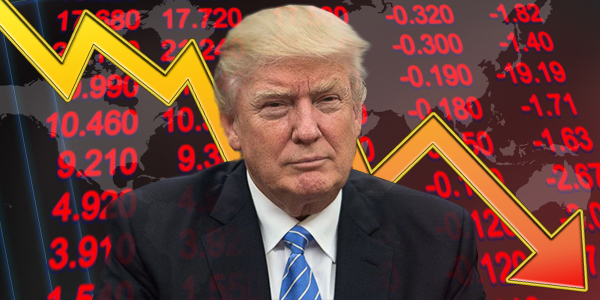Should You Worry as Trump Bump Turns into Trump Dump?

|
|
Last fall, we had the “Trump Bump.” Last week, we got the “Trump Dump.”
The Dow Industrials plunged more than 372 points on Wednesday, while the S&P 500 tanked more than 43. That was the worst, broadest one-day sell off since last September, and it was followed by additional weakness early on Thursday, before stocks later recovered.
The catalyst is obvious: Political chaos. Multiple media reports said President Trump may have pressured former FBI Director James Comey to drop an investigation into his former National Security Adviser Michael Flynn. Trump later fired Comey, and investors concluded his actions may have amounted to obstruction of justice.
That, in turn, raised concerns about potential impeachment proceedings. The controversy also threatened to derail Trump’s pro-tax-cut, pro-infrastructure-spending, anti-regulation agenda.
Deputy Attorney General Rod Rosenstein subsequently tried to tamp down some of the furor by appointing former FBI Director Robert Mueller as a special counsel. Mueller is well respected by both Republicans and Democrats, and he was empowered to investigate alleged ties and contacts between Trump allies and Russian officials.
So what does it all mean? Is this a tempest in a teapot, destined to dissipate quickly? Or is it just the start of a much deeper correction, or even a renewed bear market? Here’s my take …
I’ve seen a lot of political crises come and go in the two decades I’ve been following the markets closely. They give the Washington press corps a lot to talk about, and they clearly can cause short-term chaos. But unless they derail the underlying economy, or crush corporate earnings, they usually don’t have a lasting impact.
Just look at one of the worst such crisis in the past decade, the debt ceiling debacle in the summer of 2011. When Congress and the Obama administration couldn’t come to an agreement about raising the debt ceiling, the market panicked on the assumption it would lead to a U.S. debt default. The Dow Industrials plunged more than 2,200 points in late July and early August of that year.
Now don’t get me wrong. As a short-term trader, you can generate substantial profits from those kinds of major meltdowns. Subscribers in one of my active trading services at the time were loaded up with put option recommendations heading into the crisis. They absolutely crushed it as a result.
But I concluded the shenanigans in Washington wouldn’t tip us back into recession. And it certainly wouldn’t restart the housing and mortgage crisis that caused the Great Recession in the first place. The gradual healing process from that was already underway. So I recommended taking gains on most of those bearish positions, and moving on.
Sure enough, cooler heads ultimately prevailed. Washington came to an agreement. And the broader economy remained on a post-Great-Recession path to recovery.
In fact, by January 2012, the Dow had regained its pre-crisis peak around 12,750. It then kept on going, and even after the recent sell off, it’s still trading for more than 20,000.
So will a similar process play out this time? Should bargain-hunters step into the breach here? Well, we’re already seeing a partial recovery. Plus, I’m not seeing any major warning signs that we’re on the threshold of a full-scale recession or market meltdown — either in the credit markets or the underlying economic data.
That doesn’t mean you should just go buy every sector and stock you can. I’ve been warning repeatedly for more than a year that the auto industry is heading for a crack up. All the recent data suggests my warnings we’re right on target there.
Just a few days ago, in fact, the Wall Street Journal reported that things are so bad at Ford Motor (F, Rated “C-”) it may have to lay off as many as 20,000 employees, or 10% of its global workforce. Our Weiss Ratings model has been steadily downgrading Ford shares since 2014, and they just closed at their lowest level since fall 2012.
I also highlighted the retail sector as a potential Achilles heel earlier this year. One reason: The industry is getting disrupted by the shift from in-store, in-mall shopping to online. The SPDR S&P Retail ETF (XRT, Rated “D+”) has continued to lag badly since then, with a year-to-date decline of 6.9% as of late last week.
Not only that, but the parent company of the Justice, dressbarn, Lane Bryant, and Ann Taylor retail chains just delivered a shocking warning. Ascena Retail Group (ASNA, Rated “D”) operates more than 4,900 stores across several brands, and it said it was facing “unprecedented secular change.”
Sales and earnings will miss targets by a mile – news that sent the stock down more than 30% to a 17-year low. Weiss Ratings first downgraded ASNA to HOLD in April 2014, and to SELL in September 2015.
Outside of those industries, however, earnings and growth trends look fairly healthy. The economic data also continues to come in solid.
So I think your best move is to comb through our Ratings data in order to identify stocks with strong underlying fundamentals. Then start (gradually) legging into positions as the volatility plays out … because this doesn’t look like the start of a full-scale bear market to me.
Until next time,
Mike
ETF Spotlight Edition, by Mike Larson, Senior Analyst Mike Larson is a Senior Analyst for Weiss Ratings. A graduate of Boston University, Mike Larson formerly worked at Bankrate.com and Bloomberg News, and is regularly featured on CNBC, CNN, Fox Business News and Bloomberg Television as well as many national radio programs. Due to the astonishing accuracy of his forecasts and warnings, Mike Larson is often quoted by the Washington Post, Chicago Tribune, As-sociated Press, Reuters, CNNMoney and many others. |



